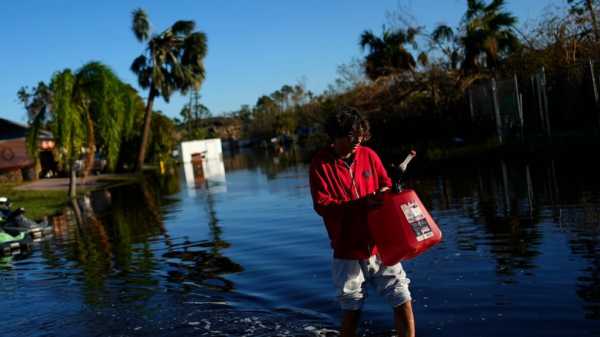
An early bird El Nino has officially formed, likely to be strong, warp weather worldwide and give an already warming Earth an extra kick of natural heat, meteorologists announced.
The National Oceanic and Atmospheric Administration Thursday issued an El Nino advisory, announcing the arrival of the climatic condition. It may not quite be like the others.
It formed a month or two earlier than most El Ninos do, which “gives it room to grow,” and there’s a 56% chance it will be considered strong and a 25% chance it reaches supersized levels, said climate scientist Michelle L’Heureux, head of NOAA’s El Nino/La Nina forecast office.
“If this El Nino tips into the largest class of events … it will be the shortest recurrence time in the historical record,” said Kim Cobb, a climate scientist at Brown University. Such a short gap between El Ninos leaves communities with less time to recover from damages to infrastructure, agriculture, and ecosystems like coral reefs.
Usually, an El Nino mutes hurricane activity in the Atlantic, giving relief to coastal areas in states from Texas to New England, Central America and the Caribbean, weary from recent record busy years. But this time, forecasters don’t see that happening, because of record hot Atlantic temperatures that would counteract the El Nino winds that normally decapitate many storms.
Hurricanes strengthen and grow when they travel over warm seawater, and the tropical regions of the Atlantic Ocean are “exceptionally warm," said Kristopher Karnauskas, associate professor at the University of Colorado Boulder. So this year, NOAA and others are predicting a near-average Atlantic hurricane season.
In the past, a strong El Nino has led to record global warmth, like in 2016 and 1998. Scientists earlier this year had been saying next year is more likely to set a record heat, especially because El Ninos usually reach peak power in winter. But this El Nino started even earlier than usual.
“The onset of El Nino has implications for placing 2023 in the running for warmest year on record when combined with climate-warming background,” said University of Georgia meteorology professor Marshall Shepherd.
An El Nino is a natural, temporary and occasional warming of part of the Pacific that shifts weather patterns across the globe, often by moving the airborne paths for storms. The world earlier this year got out of an unusually long-lasting and strong La Nina — El Nino’s flip side with cooling — that exacerbated drought in the U.S. West and augmented Atlantic hurricane season.
What this in some ways means is that some of the wild weather of the past three years – such as drought in places – will flip the opposite way.
“If you’ve been suffering three years of a profound drought like in South America, then a tilt toward wet might be a welcome to development,” L’Heureux said. “You don’t want flooding, but certainly there are portions of the world that may benefit from the onset of El Nino.”
For the next few months, during the northern summer, El Nino will most be felt in the Southern Hemisphere with “minimal impacts” in North America, L’Heureux said.
El Nino strongly tilts Australia toward drier and warmer conditions with northern South America — Brazil, Colombia and Venezuela — likely to be drier and Southeast Argentina and parts of Chile likely to be wetter, she said. India and Indonesia also tend to be dry through August in El Ninos.
While traditionally El Nino means fewer hurricanes in the Atlantic, it often means more tropical cyclones in the Pacific, L’Heureux said.
El Nino hits hardest in December through February, shifting the winter storm track farther south to the equator. The entire southern third to half of the United States, including California, is likely to be wetter in El Nino. For years, California was looking for El Nino rain relief from a decades long megadrought, but this winter’s seemingly endless atmospheric rivers made it no longer needed, she said.
The U.S. Pacific Northwest and parts of the Ohio Valley can go dry and warm, L’Heureux said.
Some of the biggest effects are likely to be seen in a hotter and drier Indonesia and adjacent parts of Asia, L’Heureux said. Also look for parts of southern Africa to go dry.
On the other hand, drought-stricken countries in northeast Africa will welcome beneficial rainfall after enduring drought conditions for several years due to prolonged La Nina events, said Azhar Ehsan, associate research scientist at Columbia University.
Some economic studies have shown that La Nina causes more damages in the United States and globally than El Nino.
One 2017 study in an economic journal found El Nino has a “growth-enhancing effect” on the economies of the United States and Europe, while it was costly for Australia, Chile, Indonesia, India, Japan, New Zealand and South Africa.
But a recent study says El Nino is far more expensive globally than previously thought, putting damage estimates in the trillions of dollars. The World Bank estimated that the 1997-1998 El Nino cost governments $45 billion.
The United States also faces hazards from El Nino despite some benefits. Ehsan noted that the increased rainfall in California, Oregon, and Washington heightens the risk of landslides and flash flooding in these areas. “While El Nino brings benefits in terms of water resource recharge, it poses certain hazards that need to be considered and managed,” he added.
___
Borenstein reported from Washington, O'Malley from Philadelphia.
___
Follow AP’s climate and environment coverage at https://apnews.com/hub/climate-and-environment
___
Follow Seth Borenstein on Twitter at @borenbears
___
Associated Press climate and environmental coverage receives support from several private foundations. See more about AP’s climate initiative here. The AP is solely responsible for all content.
Sourse: abcnews.go.com





